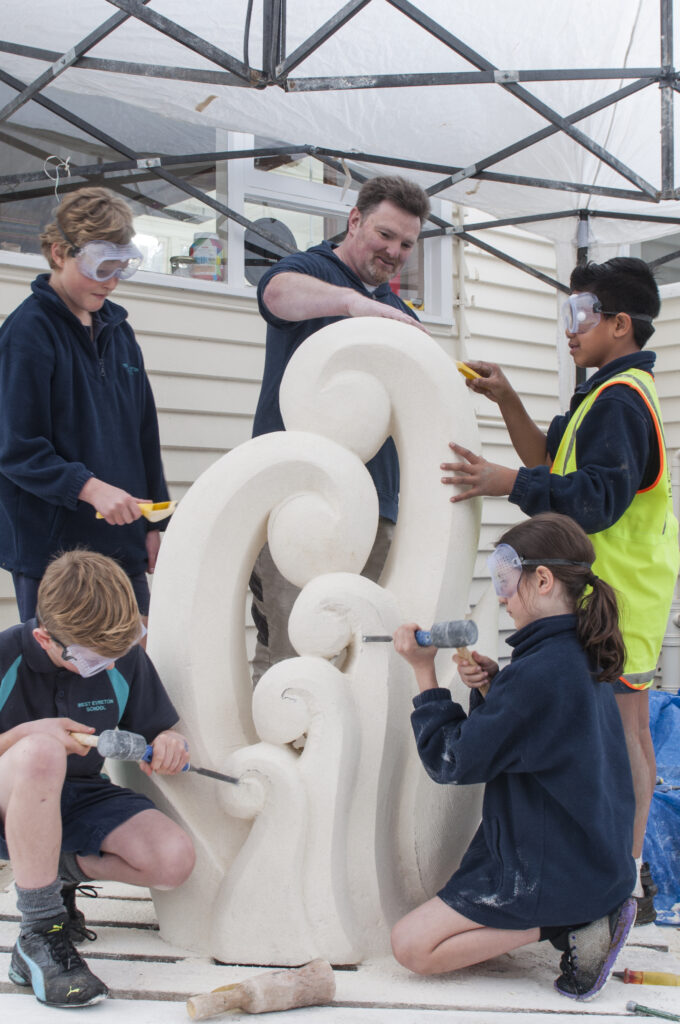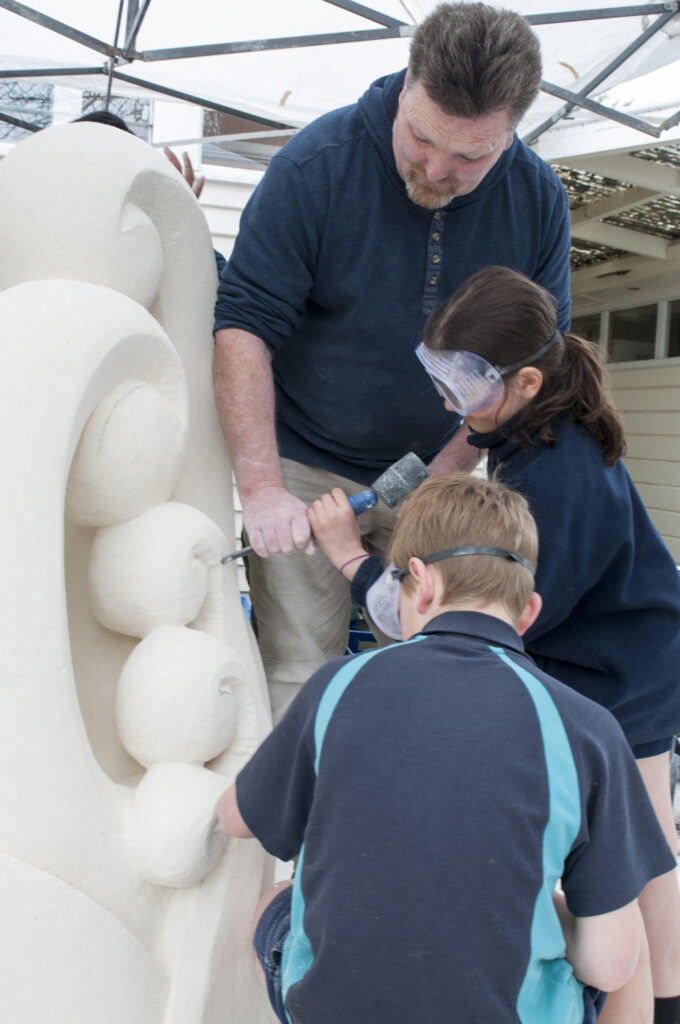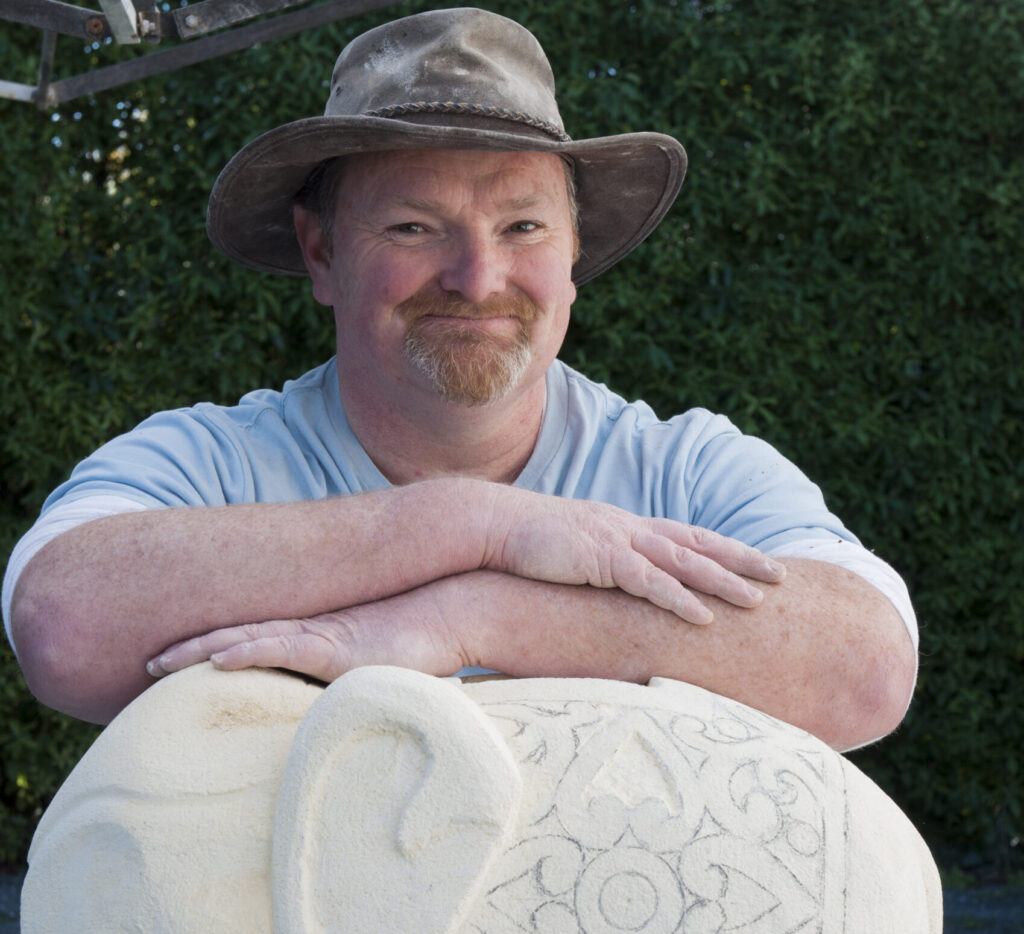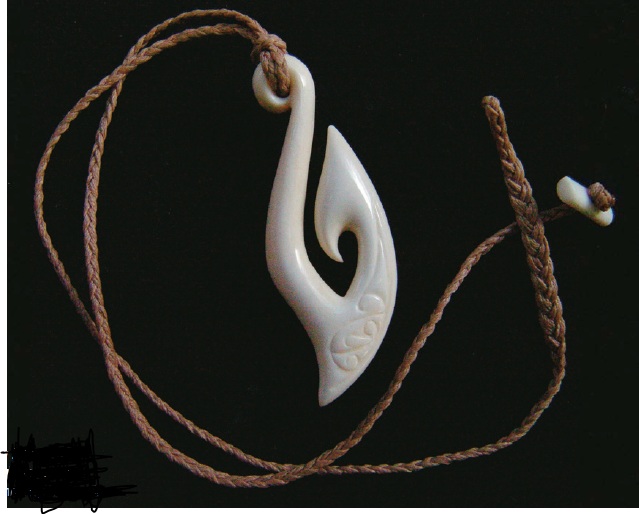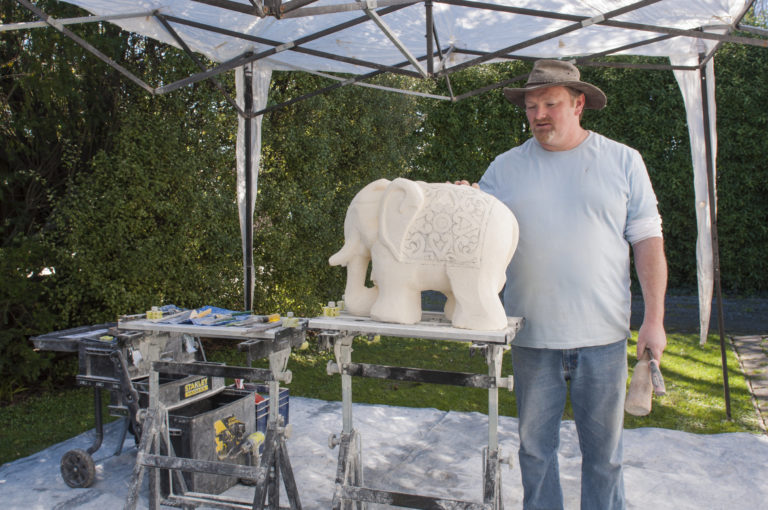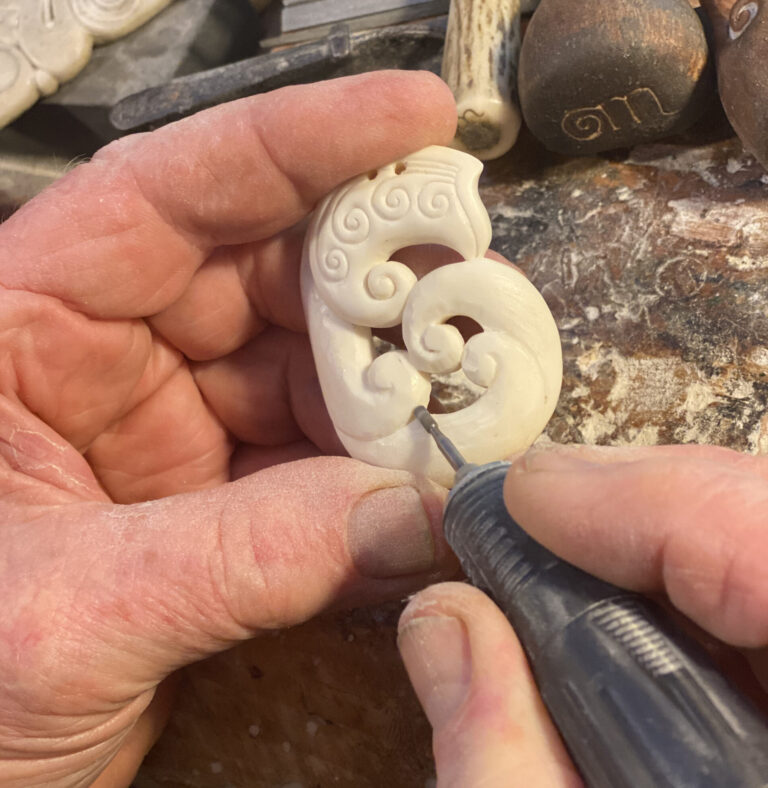Ditching the day job for a full-time role as sculptor and teacher is the best thing this artist has ever done
By Sue Allison
Photographs: Juliet Nicholas
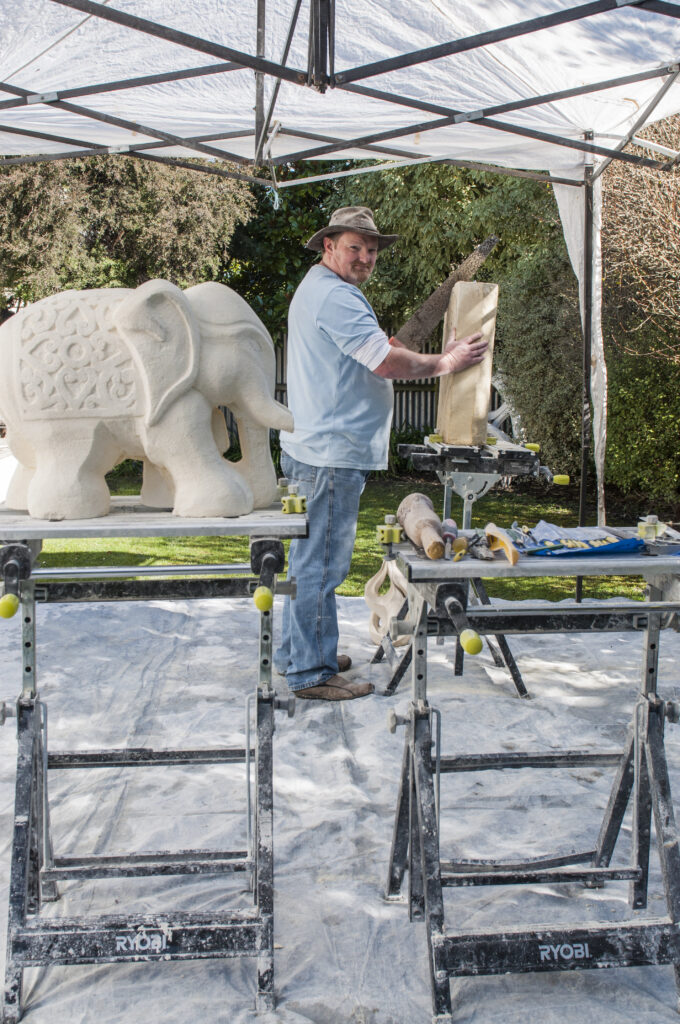
Shaugn Briggs’ shed is a 6m x 3m pop-up gazebo and heavy-duty groundsheet. And that’s just on a bad day. When the sun is shining, the Christchurch limestone carver works alfresco, with the sky overhead and surrounded by trees and music.
The shedless sheddie’s “workshop” consists of a pile of portable Ryobi benches and an assortment of tools in stackable plastic tubes. When not stored in the single garage at the end of his drive, they are loaded on the trailer he tows around to various working and teaching venues.
Shaugn, who is also an accomplished painter, started his working life, somewhat reluctantly, as a painter and decorator. “The art thing was all I ever wanted to do but there is always that pressure to get a proper job,” he says.
He was first introduced to stone carving about 15 years ago when he came across a sculpture symposium in Hagley Park. “I found a piece of Oamaru stone and started having a play,” he says. Not long afterwards, he spotted some leftover blocks of the limestone at a worksite while on a job. After making a few inquiries, he was invited to help himself and headed home with a van-load of stone. “Everyone thought I’d gone mad, but I was over the moon.”
Shaugn was soon spending all his spare time carving in the garden of the St Albans house he shares with wife, Benita Rarere-Briggs, a lecturer in early childhood education. A couple of years later, with his paintings and sculptures selling well and “dead bored” with his day job, he took the big step of tossing it in to work as a full-time artist. His decision was partly sparked by reading a book by the motivational author Dr Wayne Dyer titled Don’t Die With Your Music Still In You. “I just changed ‘music’ for ‘art’.”
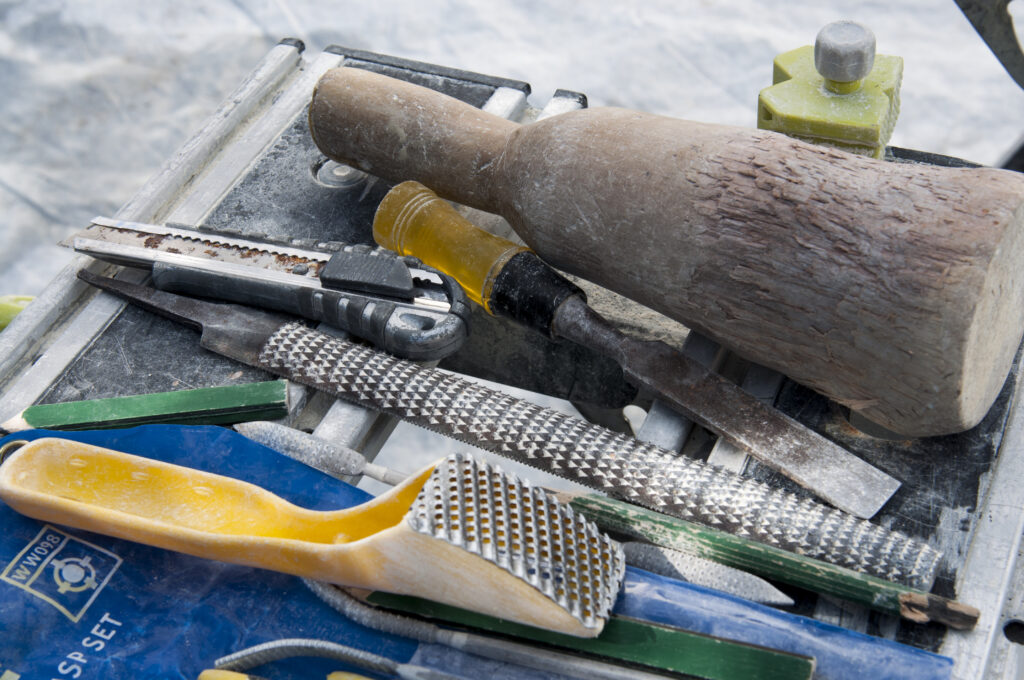
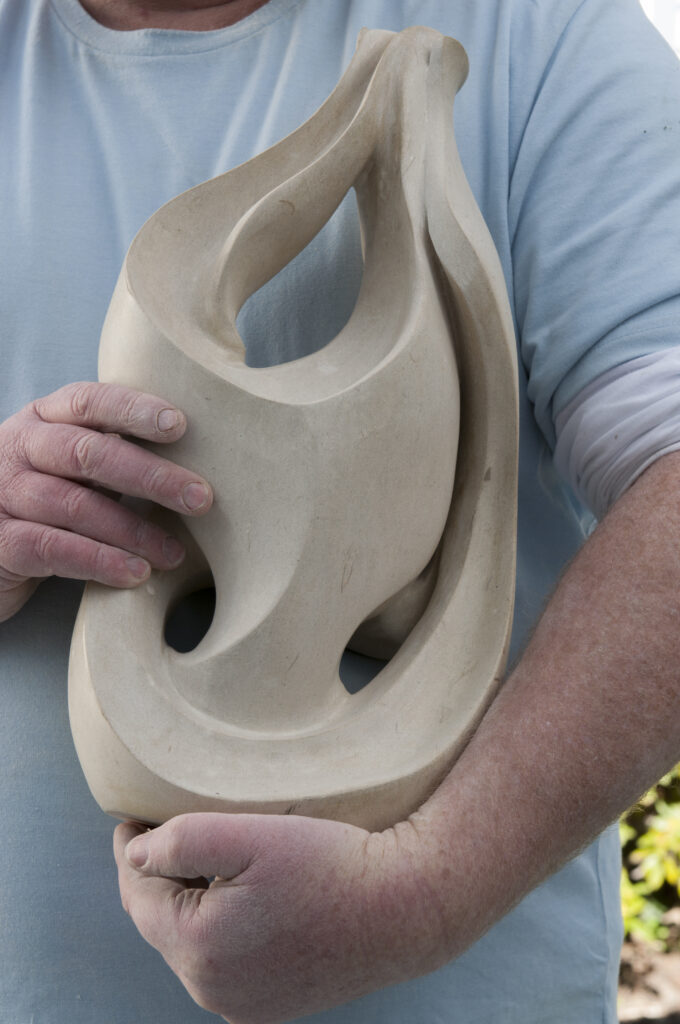
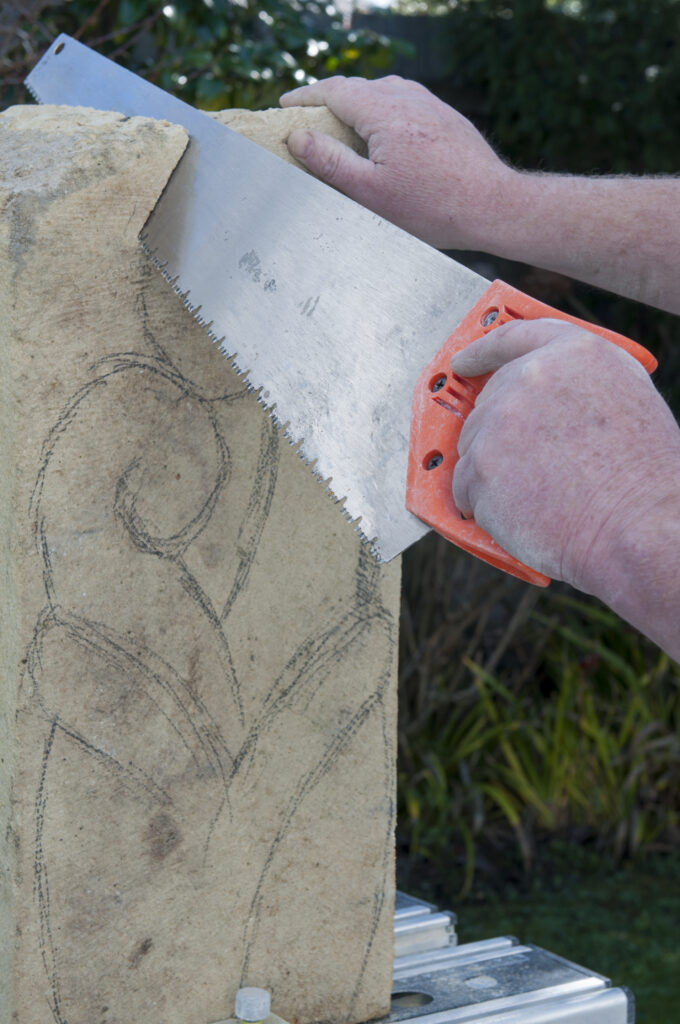
Time to start teaching
The next step, which hadn’t been part of the plan, was to add teaching to his skill set. It came about after finishing a large commissioned sculpture, The Goddess of Flora, for the Packe St Park and Community Garden. After the unveiling, he decided to show people the basics of stone carving using the off-cuts.
“I was then encouraged to teach stone carving through night classes. I was really getting outside my comfort zone but decided to take on the challenge,” says Shaugn, who admits to having been “petrified” the first time he stood in front of a class but now loves it. “Teaching makes you a better person. You learn to be really patient and compassionate. I’ve also met some fantastic people.”
Thirteen years on, as well as taking adult night classes at Papanui High School, he runs school holiday programmes, corporate and festival workshops and classes for clubs and community groups. His most recent teaching venture has been to set up downloadable carving lessons whereby people can purchase a project containing a full set of instructions backed up by photos to help them through the process.
“Stone carving gives people a chance to be creative by using a simple medium,” he says. “For some, it’s their first introduction to the arts. Whatever their skill level, they can go from a basic sculpture to designing and creating some really good works of art.”
For Shaugn, the challenge and satisfaction of carving is in turning an inanimate block of stone into an artwork that has flow and movement. He is methodical in his approach, tackling one project at a time. “I like to do a job and get it done. I usually start about 9ish in the morning and often work till dark,” he says. “I just love being out there with music playing getting into my creative zone. I look forward to it every day.”
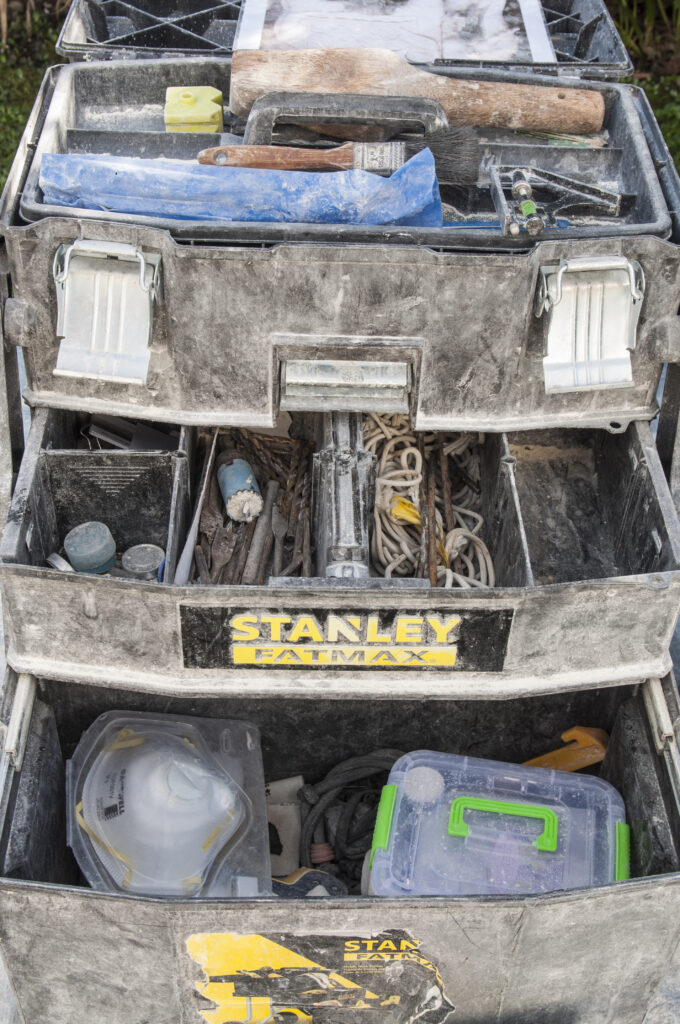
Tools and process
You don’t need specialist stone chisels and tools to carve Oamaru stone. “Anything that works with wood works with limestone,” says Shaugn, who recommends starting off with a set of standard wood-carving chisels. “It’s not until you choose to sculpt much harder stone like marble that you will need to buy professional masonry chisels.”
Shaugn starts larger sculptures on pallets, raising them onto his portable workbench once enough has been cut away for them to be light enough to lift. He swears by adjustable Ryobi benches as the best working surface for carving stone. “It not only allows you to work at a comfortable height, but also has the huge advantage over a fixed bench in that you can move around your sculpture and work on it from all angles without having to turn it all the time.”
His adjustable bench can hold up to about 90kg and lifts and locks to a height of around 1.2metres. Shaugn has drilled holes to hold his hand tools alongside the working surface, which can be enlarged or contracted by winding a pair of handles. He warns aspiring stone carvers to avoid cheaper benches that tend to be flimsy and less durable.
Workbench clamps are essential for holding the stone, thus freeing your hands and minimising the chance of cutting yourself, he says. “Never hold your carving with one hand and try to use the blade with the other. It’s amazing how much damage it can do if it slips and cuts you.” The free-standing bench has the added safety factor of making it easy to carve from all sides and avoid any temptation not to work with the chisel blade facing away from you.
Shaugn first draws his design on the rectangular block of stone with a builder’s pencil. For some commissions, he will be given a picture to copy; for others he downloads and adapts images from the internet.
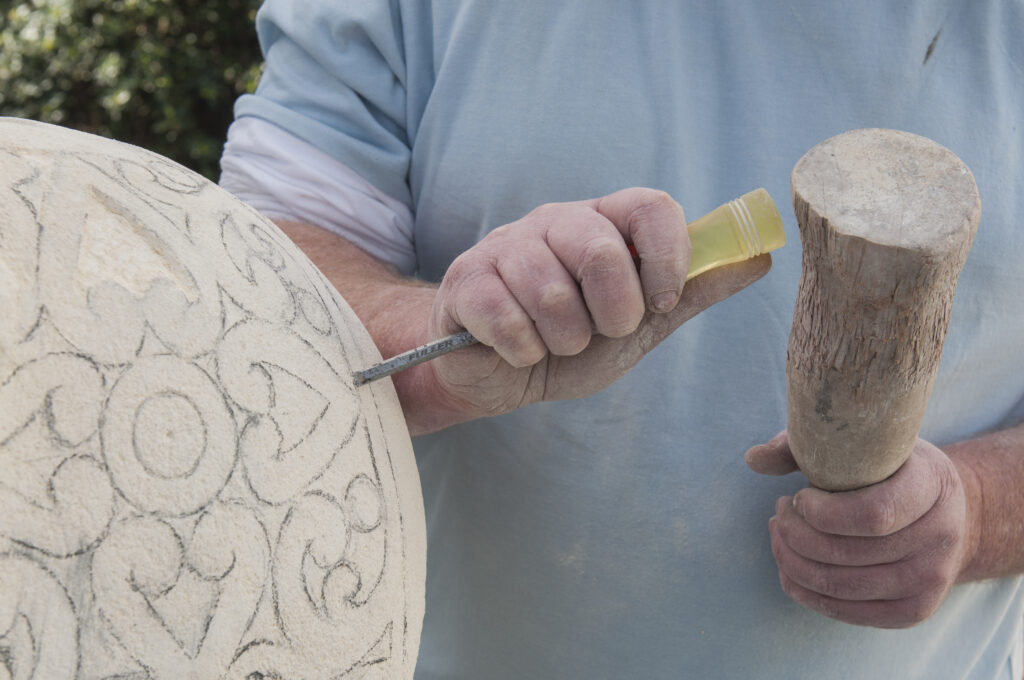
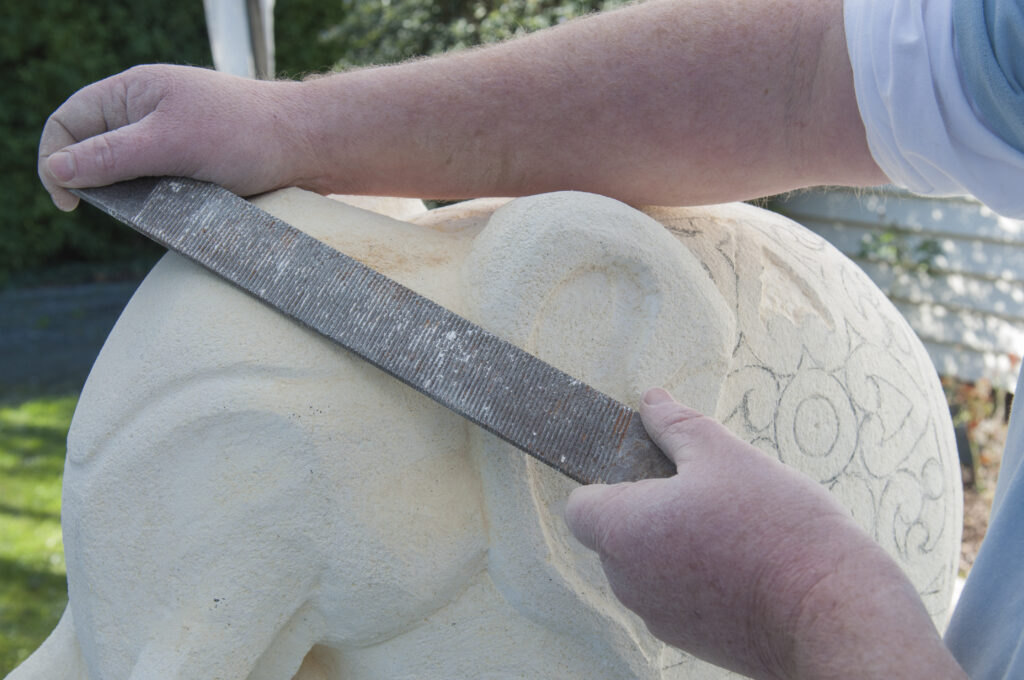
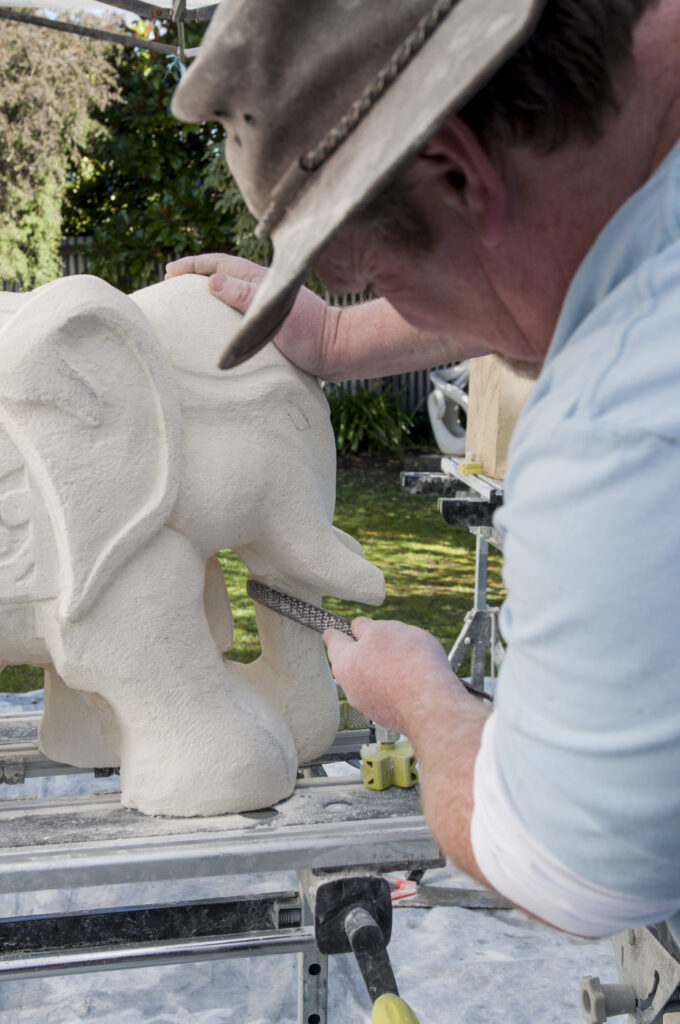
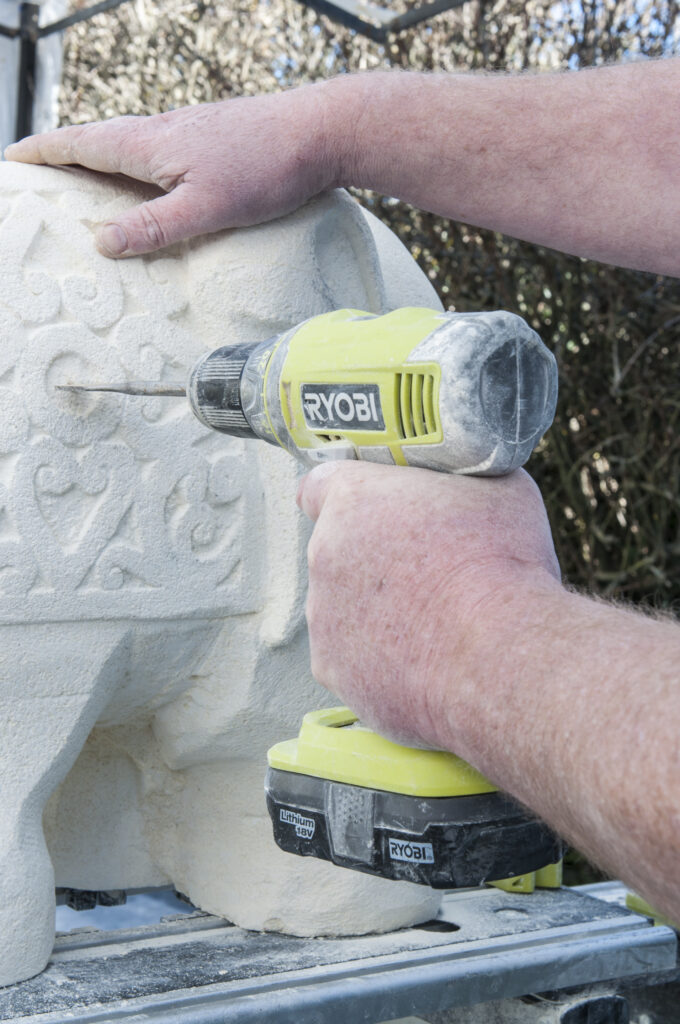
Hand tools are first choice
He uses ordinary wood saws to cut the block into the general shape. “It’s a bit like sawing through a branch,” says Shaugn, who then roughs out the form with a hammer and steel-tip chisels. “I don’t use electrical tools much as they are too fast.” Cordless battery-powered tools do have their uses, however, particularly grinders for cutting curves and spade bits for drilling holes.
Limestone is not particularly dusty, nor is it harmful except for people with respiratory conditions such as asthma. “Because I do a lot of teaching indoors, I checked with the Health Department,” says Shaugn, who wears goggles when using power tools or heavy-duty chisels to avoid flying fragments.
The bulk of the shaping is done with hand chisels, and Shaugn recommends having a good range of sizes. He also has a variety of wooden mallets, including a well-worn one inherited from his father who was an upholsterer.
“It’s not until the general design has been shaped out with saws and chisels that you move onto tools like files and rasps,” he says. At this point, a messy sculpture covered with chisel marks and gouges is transformed into one with smooth lines and flowing curves. Shaugn starts the refining process with a coarse file, often his 250mm (10inch) half-round wood file. “It’s a toothy file which is great for removing excess stone and the flat side is good for general smoothing down,” he says. “It’s also good for dealing with sculptures that have a hole drilled through them or if there is a tubular space that’s tricky to get into.”
As far as rasps go, his top recommendation is the Surform shaver or “cheese grater” rasp. Operated with a pulling motion, it is simple to use and its small, slightly curved blade makes it easy to access most parts of the sculpture. “Bigger rasps work well with large sculptures but can be clumsy in tight areas. This does a good job in most situations,” he says. It also has a snap-on blade that is cheap to replace.
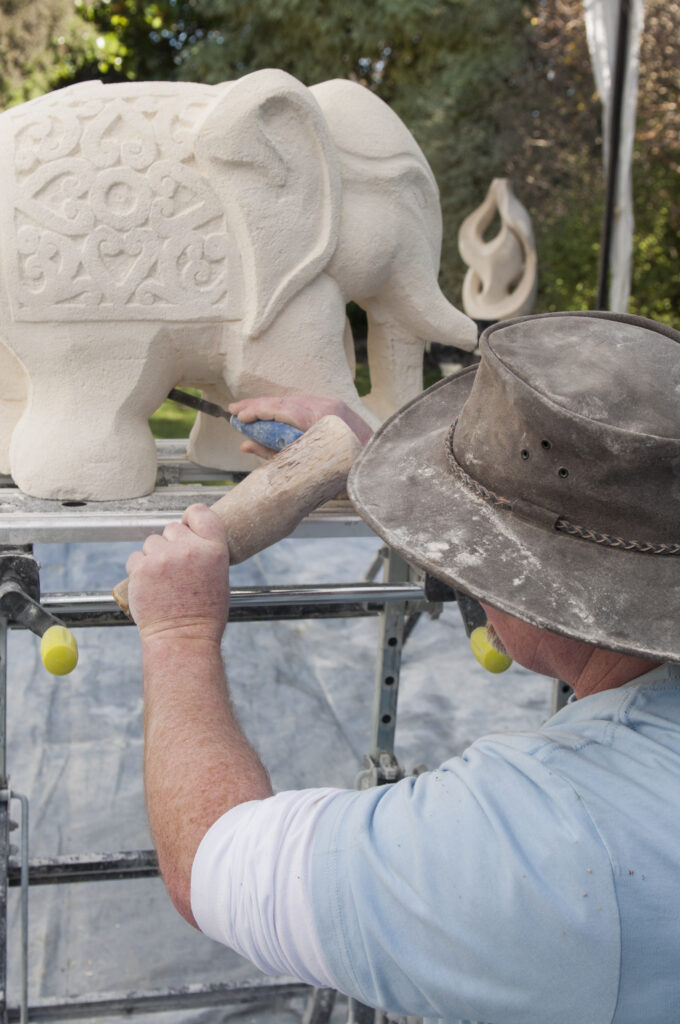
Favourite tools
Detail and finishing touches are achieved using fine chisels and riffler files. The little riffler files, which resemble dental instruments, are among Shaugn’s favourite tools. They can be hard to find in hardware stores but can be purchased online individually or in sets.
“Riffler files are really effective for detailed work. Once you’ve tried them you’ll wonder how you managed without them,” he says. “I find them excellent when trying to replicate muscle definition or facial features, but they’re equally handy when working on larger sculptures such as an abstract where the stone is shaped into bends and twists as you’ve got a greater measure of control than with a rasp.”
Shaugn used a range of riffler files to painstakingly carve basket weave on one abstract work, then replicated the texture of flax by “combing” the stone with a keyhole saw blade. “It was incredibly difficult to make the strands look as though they flowed over and under each other.”
For a very fine finish, Shaugn uses sandpaper of varying grits.
As limestone is porous, it needs to be sealed if it’s going to be displayed outside. Even if indoors, sealant is advisable so the carving is protected and doesn’t leave powdery residue on surfaces. A waterproof masonry sealer designed for exterior dwellings is ideal, either water-based or solvent-based. If new to stone carving, Shaugn recommends using a water-based silicone sealer for both interior and exterior sculptures. It can be purchased in a spray can but it is cheaper to buy the concentrate and mix it yourself. “I use one part silicone to 14 parts water and use a pump spray bottle to apply it,” he says.
Shaugn’s website is full of information and YouTube clips about limestone carving: www.learnstonecarving.com


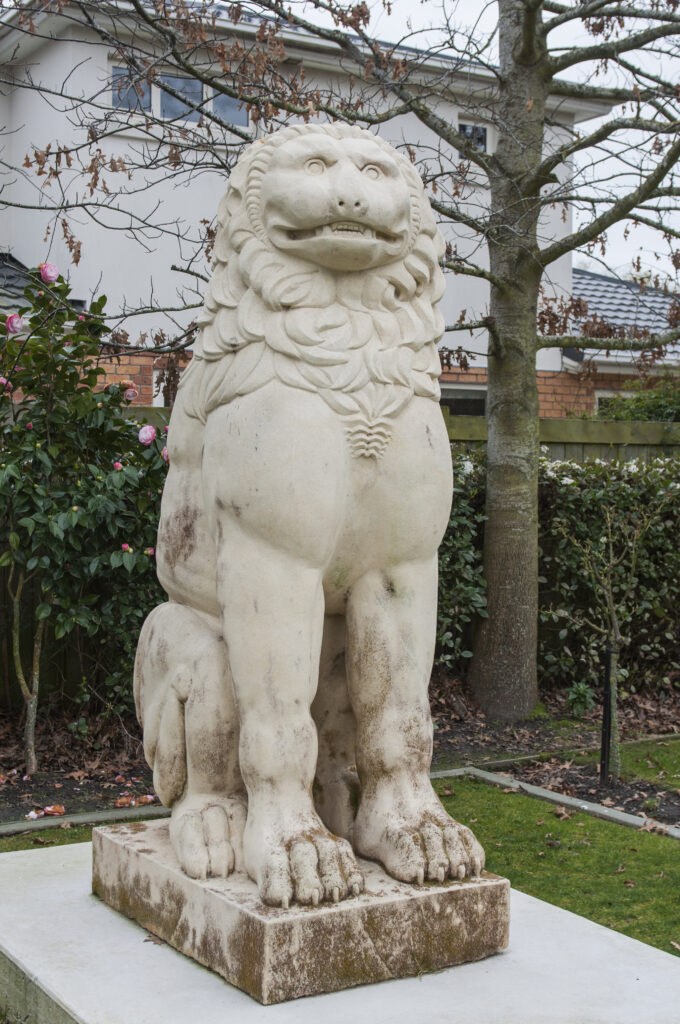
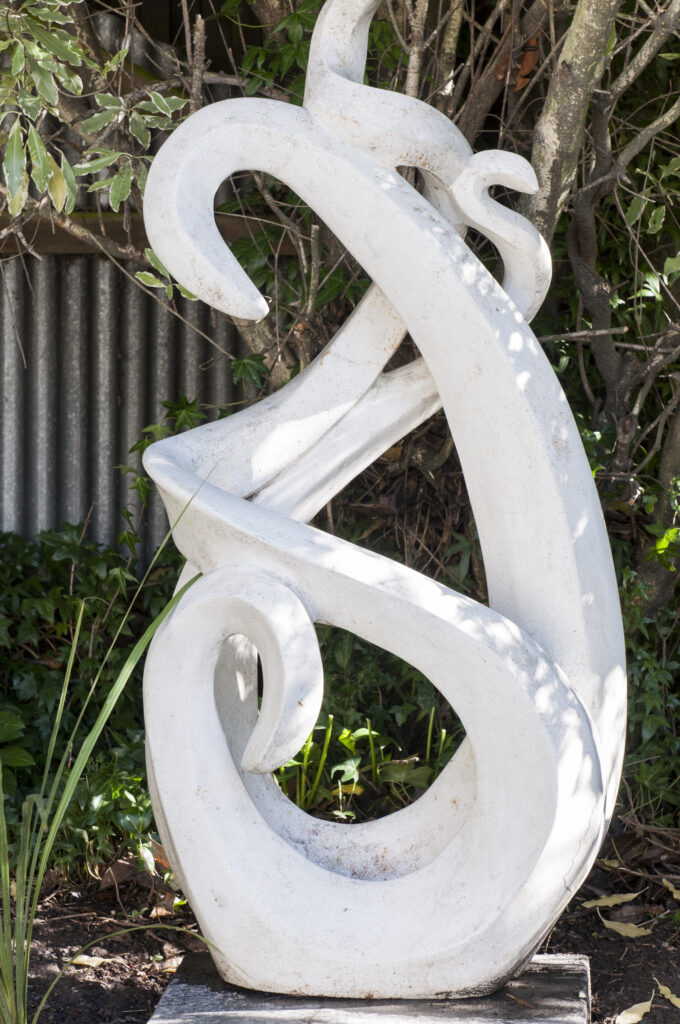
ABOUT THE STONE
Oamaru stone, sometimes called whitestone, comes from a 40-metre thick deposit of limestone 5km inland from the North Otago township of Oamaru. The distinctive creamy-coloured stone is bryozoan limestone, which is made up predominantly of calcium carbonate (90 percent) with trace chemicals including alumina (1.5 percent), iron oxide (0.5 percent) and silica (0.5 percent).
The sedimentary rock is soft when first quarried but hardens on exposure to air. This, along with its uniform granular texture, makes it excellent for sculptural and ornamental purposes. As it is porous, it must be sealed if outside. “If it stays wet for a long time, the stone will go mushy and begin to break down,” says Shaugn.
The stone has been quarried at various sites along the deposit since the 1860s, but Parkside Quarries at Weston, which opened in 1906, is the only remaining operation. It was originally sliced from the hillside using a steam-driven chainsaw mounted on rails, but these days is cut with hydraulically operated, 3-metre tungsten-tipped circular saws.
The stone has been widely used as a building material in Oamaru, but also features on prominent buildings around the country, from Dunedin’s historic railway station to the Auckland Town Hall.
Mt Somers limestone, found in mid-Canterbury, is denser than Oamaru stone but its treatment is the same for carving. “You use the same tools but everything takes two or three times longer,” says Shaugn.

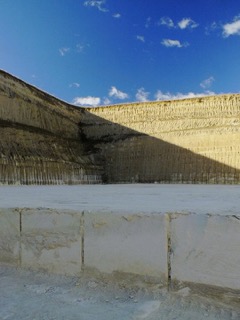
SCHOOL SCULPTURE
When West Eyreton School wanted its core values set in stone, they decided Shaugn was the man for the job. A striking limestone sculpture is now mounted inside the school gates, its five koru depicting the school’s sought-after Es of excellence, empathy, example, enterprise, and effort.
Those values were reflected in the nature of the project itself, with every student at the North Canterbury primary school involved in creating the work of art.
Shaugn designed the sculpture and, once it had the school’s approval, organised delivery of the massive block of Oamaru stone which weighed over a tonne.
He spent every school day for three weeks demonstrating carving techniques to different groups of children, then letting them work on the sculpture. The older students carved with chisels while the younger ones finished things off with rasps and sandpaper.
“It’s been a great project with the children involved along the whole journey,” says principal Jillian Gallagher. They worked under his gazebo during the mid-winter project, and Shaugn also turned the school’s covered walkway into a workshop for Year 7 and 8 students to carve ornamental koru and candleholders.
“We’ve loved this opportunity, and it’s only been possible because Shaugn brings his shed to us,” says Jillian. “We couldn’t have taken the whole school into town over three weeks. This way not only has every child been able to work on it, but we have been able to watch it evolve day by day.”
